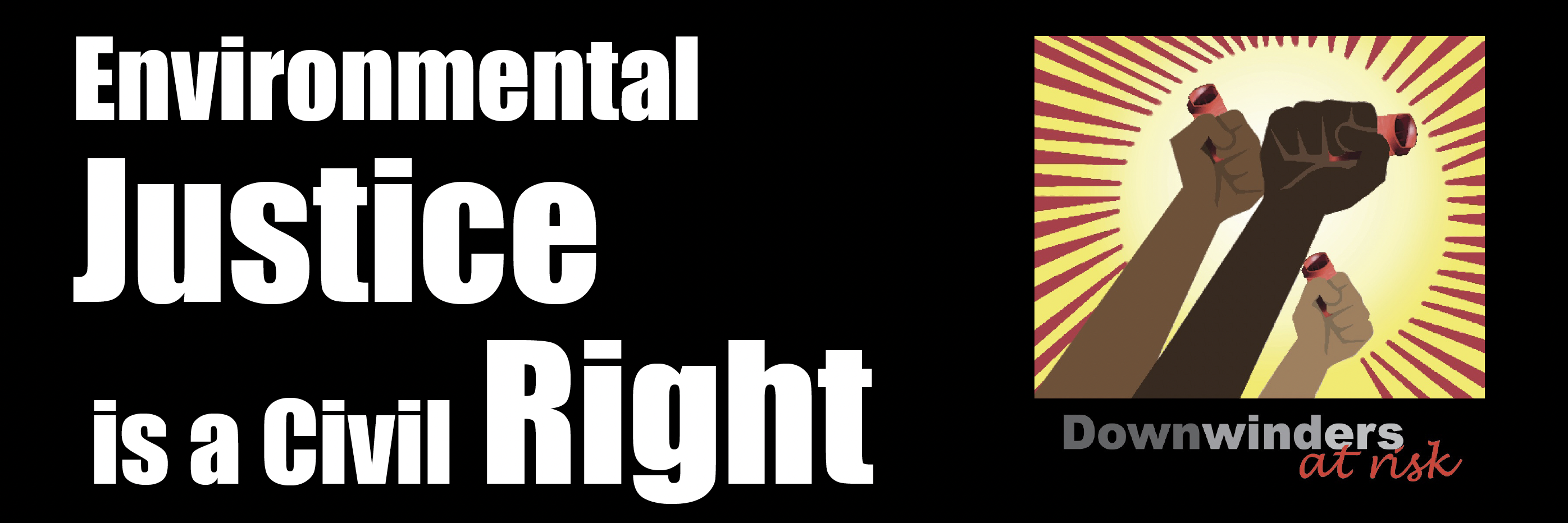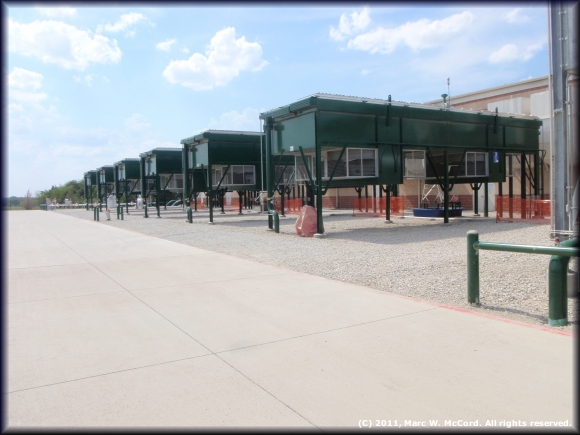Natural Gas
We Need Your Help on Wednesday
 Dallas is writing a new gas drilling ordinance. As part of this new set of rules, we have a chance to win the nation's first "off-sets" program for air pollution from gas drilling and processing.
Dallas is writing a new gas drilling ordinance. As part of this new set of rules, we have a chance to win the nation's first "off-sets" program for air pollution from gas drilling and processing.
Off-sets would require gas operators to pay for decreasing as much greenhouse gas air pollution as they're estimated to emit every year. If a company's annual air pollution emissions total 5 tons a year, it would have to fund projects that would reduce air pollution by 5 tons a year.
Every other major industrial source of air pollution in the DFW area is already subject to off-sets because of anti-smog regulations. Even though they can emit more air pollution than many of these industrial sources, a loophole allows gas operators to escape this requirement.
Greenhouse gases include smog-forming Nitrogen Oxide, CO2, and methane. Applying this program means Dallas would be the first local government in the country to require the gas industry off-sets. This would set a precedent and could be copied by other local governments in North Texas, just like Downwinders' Green Cement policies. And like those Green Cement policies, they could lead to significant air pollution reductions all over the region.
Off-sets help balance the costs of drilling by better reflecting its true impact. They act as an incentive to reduce pollution at the source. Together with larger buffer zones protecting homes and schools, and bans on drilling in parks and floodplains, off-sets can be part of a much tougher Dallas ordinance.
If off-sets are not required, new increases in gas industry emissions will continue to cancel out the kind of progress we've all worked so hard to achieve. As drilling has marched east, air monitors officially violating the old 85 parts per billion ozone standard have moved east as well. This year, we've already seen a monitor at I-35 and Mockingbird in inner city Dallas violate that standard – something it had not done since 2005.
We're now in the final stages of decision-making about the content of the Dallas ordinance. Beginning at 1 pm Wednesday at Dallas City Hall in Room 6ES, there's going to be a showdown of industry vs citizens.
Notorious gas industry PR spinmeister Ed Ireland will be speaking for 15 minutes about why Dallas needs to keep regulations loose. Attorney and Dallas gas drilling task force member Terry Welch will get 15 minutes to explain why the city needs to get tougher in its rules for drilling. Then the City Council will get to ask questions. No final decision for now, but the tone that's set at this "briefing session" will be critical.
Even if you don't live in Dallas, you have a stake in this decision. The pollution spewed by the gas industry in Dallas can become smog over Arlington, Ft. Worth, Denton, or Weatherford.
To be sure the Council members understand how important this issue is to Dallas' future and your present, we need you there at City Hall on Wednesday. Nothing says "concern" better than lots of people showing up to watch what happens. Likewise, empty seats are taken to mean there isn't much interest. It's during a workday, but if you can come, or send someone in your place, the effort will be worth it.
Videos and Pics of the DC Frack Attack Rally
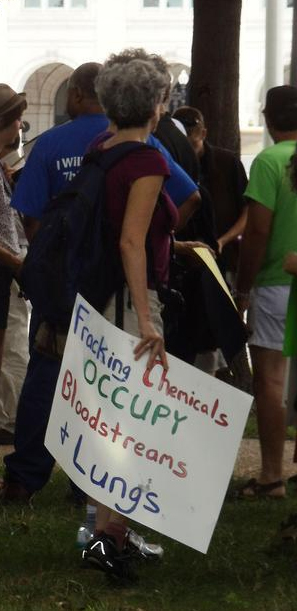 Via the Digital Journal, and Flickr here's a good sampling to give you a taste if you weren't there.
Via the Digital Journal, and Flickr here's a good sampling to give you a taste if you weren't there.
Think Nationally. Act Rationally. Stop the Frack Attack in Dallas
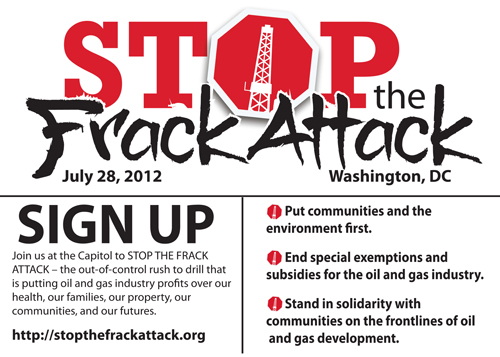 We want to extend a big ol' thank you to all those Barnett Shale residents who are in our nation's capital right now getting ready to attend the largest national rally on fracking ever held in the US.
We want to extend a big ol' thank you to all those Barnett Shale residents who are in our nation's capital right now getting ready to attend the largest national rally on fracking ever held in the US.
Former DISH Mayor Calvin Tillman, Earthworks' Sharon Wilson, former Decatur resident and gas victim Tim Ruggiero, are all among those up in Washington, giving interviews and raising constructive hell with the Texas Congressional delegation. Along with Don Young and CANDO, Gary Hogan and the folks at the North Central Texas Communities Alliance, and Susan Read in Grand Prairie, these are the most stalwart heroes of our local Shale fight.
Going on seven years now, they've been taking on the Oil and Gas industry in Texas (spend a moment thinking about what that means) on behalf of not only their own neighborhoods, but ours as well. And they started without all the evidence we have now about the hazards of fracking – known and unknown. All they had was their common sense and intuition.
And it was very lonely. For so long it was only the Barnett Shale that was in play. Only the middle of the country, in places where the nation's press wasn't headquartered, where celebs didn't have their summer homes, where, it seemed, nobody that could help them, cared about them.
Traditional environmental groups who they thought might side with them were instead being funded by their opponents because "natural gas was so much cleaner than coal." Non-traditional ones, like Downwinders we're sorry to say, were just not paying enough attention or had their own full agendas. So this first generation of fracking opponents had to start from scratch, with none of the resources, expertise, or support that just about any other environmental cause could expect to receive.
But they kept at it. And they built a huge library of real world knowledge about fracking. Not the theoretical PR clams, but what actually happens to people and land when the rigs show up. Their knowledge was so essential that a budding film maker named Josh Fox knew he had to make the Barnett Shale one of the stops to talk with them for his new film "Gasland." Their knowledge was going national just like the drilling.
Because as usually happens, greed got the better of an industry. The gas companies couldn't stop with the Barnett, or other rural western plays. They had to go east, to Pennsylvania, to New York, within hours of Manhattan. They began to imperial the summer homes, or water sources, or views, or health of very rich and powerful people who have access to more resources than your average angry DFW resident. Fracking got more media attention. It got more research attention in academia. It's becoming a part of popular culture. David Letterman is now ranting about fracking.
And tomorrow's rally in DC makes it official – fracking is now a national environmental controversy that's forcing citizens to build a national environmental movement. At the center of that movement, and somewhere in the center of that crowd tomorrow, stands those folks from the Barnett Shale who are finally seeing their cause get the kind of attention it deserves. It will be a banner day. Better late than never.
How can you help that movement if you're not in DC this week? By exploiting every opportunity to use what we now know about Fracking thanks to those early activists.
The largest city in the Barnett Shale is in the final stretch of writing a new gas drilling ordinance. This Wednesday at 1 pm on the 6th floor of Dallas City Hall, the City Council will be receiving its second briefing on the hazards of fracking. We need you there to show the Council you're interested in seeing a strong and protective ordinance. In Dallas, we have a chance to make progress in making the industry begin to pay for its own pollution, to set precedents that will be important. We can win. We can make things better. We can honor those whose work has given us a multitude of evidence of harm by using it to grab this Dallas ordinance by the horns and make the most out of it. Want to support the national anti-fracking movement? Think Nationally. Act Rationally in Dallas.
One Week From Today: Gas Drilling Showdown at Dallas City Hall
What To Expect When You’re Expecting Gas Drilling
If you're a Dallas resident and you want to find out more about the kinds of new facilities that might be located near you if gas drilling is allowed in your city per the new ordinance the Council is debating on August 1st, here's a item of interest from West Virginia, where operators are already fracking.
"Sulfur dioxide, carbon monoxide and formaldehyde are some of the chemicals Chesapeake Energy is likely to pump into the air in Ohio County from its numerous drilling sites, company information states.
Earlier this year, Chesapeake officials confirmed plans to build local compressor stations that may release these and other chemicals into the atmosphere. Now, the company is identifying "potential to emit" levels for several potentially hazardous materials from its well drilling sites.
The amounts of the particulates that may be released at the four sites slightly vary. The carbon monoxide projections, for example, range from 40 tons per year to 61.5 tons per year to be released from a single site.
In addition to the pollution from the well sites, Chesapeake also will release emissions from its local compressor stations. Chesapeake, in a legal advertisement earlier this year, confirmed the "potential to discharge" the following amounts of these materials on an annual basis from the operations at the compressor stations: carbon dioxide – 93,800 tons; nitrogen oxides – 82.96 tons; carbon monoxide – 16.87 tons; methane – 86.64; carbon dioxide equivalent – 95,667 tons; benzene – 0.33 tons; and formaldehyde – 3.22 tons."
Formaldehyde and Benzene are both carcinogens. Carbon Dioxide is the primary greenhouse gas pollutant, and methane is right behind. Nitrogen Oxide is the primary component of smog in DFW. All this – 93,000 tons a year of air pollution – from just one gas compressor. Where in Dallas would you propose to put a facility that spews that much air pollution? And how would you keep it from adding to the chronic air quality problem the City already has? And then what about the fact that the operators might not need just one, but three, or five, or ten of these compressors in Dallas? It's not uncommon to build complexes that house as many as a dozen or more locomotive-size compressors in the Barnett Shale, which includes at least the western half of Dallas.
When you allow drilling, you're allowing everything else that follows drilling, including compressors and their pollution, storage tanks that leak copious amounts of the same kind of pollution, pipelines that can use eminent domain to run through your front yard, and a host of other hazards, some of which we know about, some of which we no doubt have not yet discovered. Gas mining is not conducive to neighborhoods or attracting new, non-polluting development. If Dallas City Hall doesn't know this now, it most certainly will learn it later.
Low Birth Weight Pregnancies 25% More Likely Within 1.5 miles of Fracking
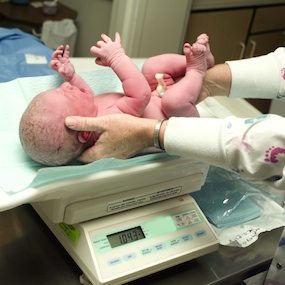 A mother's exposure to fracking increases the chance a a low weight birth by 25%, according to a new study by Elaine Hill, a doctoral candidate at Cornell University. Hill's research also found a 17% increase in "small for gestational age" births and reduced health scores among newborns whose moms lived close to fracking sites.
A mother's exposure to fracking increases the chance a a low weight birth by 25%, according to a new study by Elaine Hill, a doctoral candidate at Cornell University. Hill's research also found a 17% increase in "small for gestational age" births and reduced health scores among newborns whose moms lived close to fracking sites.
“Unconventional Natural Gas Development and Infant Health: Evidence from Pennsylvania” is the working title of the study, which has not yet been peer-reviewed or journal-published. Hill used data from 2010 and focused on those living up to 1.5 miles from gas development sites. Pennsylvania increased its unconventional natural gas wells from 20 in 2007 to 4,272 by the end of 2010.
Hill publicized her findings at a public hearing in New York state, which is considering new regulations for fracking. She decided to come forward now, rather than wait for up to two years for the review process to accredit her research because she believes her study has implications policy makers need to incorporate into those regulations.
“My study is robust across multiple specifications and it indicates that our future generation may be seriously harmed. I couldn’t possibly value my career over their well-being,” Hill said by email last Thursday.
We already have a Colorado School of Public health study released in March that shows a 66% higher chance of getting cancer if you live within a half mile of a fracking site. Hill's study is the first to track health effects up to a mile and a half away.
These reports are in addition to the hazard of earthquakes now officially linked to fracking waste injection wells by the US Geological Society, and the risk of getting silicosis from breathing in illegal levels of sand particles noted by industrial hygienists – both from earlier this year. All of this is new research that didn't exist before 2012. What other hazards are we ignorant of this year?
Just another reason why you should be at Dallas City Hall at 9 am on Wednesday, August 1st for the Thrilla on Marilla.
State Farm Sending Letters To Johnson County Residents Offering Earthquake Insurance
 Following up on our follow-up….while no insurance companies offer homeowners protection against the hazards of fracking out right, State Farm seems to have figured out how to make money selling insurance for the symptoms of disposing of fracking waste. Buried deep inside this story on the recent wave of Johnson County earthquakes and their possible link to the County's numerous high-pressure injection wells for "fracking fluid" is the news that the Insurance giant sent out letters to Johnson County residents urging them to buy earthquake coverage.
Following up on our follow-up….while no insurance companies offer homeowners protection against the hazards of fracking out right, State Farm seems to have figured out how to make money selling insurance for the symptoms of disposing of fracking waste. Buried deep inside this story on the recent wave of Johnson County earthquakes and their possible link to the County's numerous high-pressure injection wells for "fracking fluid" is the news that the Insurance giant sent out letters to Johnson County residents urging them to buy earthquake coverage.
If, as recently as five or six years ago, an enterprising insurance agent had tried to sell a Cleburne resident earthquake insurance, he would have been investigated for fraud. This is how fracking has changed North Texas.
Green Source Coverage of Dallas Drilling Fight
 The folks over at Green Source continue to up their current events coverage of local environmental issues. This week it's a feature on the local "supergroup" of Dallas Residents at Risk, of which Downwinders is a proud member. DRR membership, whch also incudes the Dallas Sierra Club, Texas Campaign for the Environment, and the Mountian Creek Neighborhhood Alliance, has been instrumental in moving the fracking debate out of environmental circles and into Dallas neighborhoods. It's also set the agenda for the debate with its "five protections" proposal to improve the proposed new gas ordinance. This is going to be a close vote no matter what. Don't forget to be there at Dallas City Hall on August 1 for the next round.
The folks over at Green Source continue to up their current events coverage of local environmental issues. This week it's a feature on the local "supergroup" of Dallas Residents at Risk, of which Downwinders is a proud member. DRR membership, whch also incudes the Dallas Sierra Club, Texas Campaign for the Environment, and the Mountian Creek Neighborhhood Alliance, has been instrumental in moving the fracking debate out of environmental circles and into Dallas neighborhoods. It's also set the agenda for the debate with its "five protections" proposal to improve the proposed new gas ordinance. This is going to be a close vote no matter what. Don't forget to be there at Dallas City Hall on August 1 for the next round.
“How your great grandmother’s chemical exposures may affect you”
 In a study published this week, "rats exposed in the womb to five common environmental pollutants passed on DNA-changing attributes that persisted in causing ovarian cancer three generation removed from the original exposure."
In a study published this week, "rats exposed in the womb to five common environmental pollutants passed on DNA-changing attributes that persisted in causing ovarian cancer three generation removed from the original exposure."
It's another example of "epigenetics" – when harmful environmental exposures to one generation can skip a generation or two and show up as health effects decades later.
According to the new study, the five pollutants reprogram how DNA is expressed in the developing fetus' eggs, setting the stage for ovarian disease later in their life.
If you're a Vet, the news is worse. The U.S. Department of Defense helped select the pollutants based on potential exposures in military personnel. They included vinclozolin, a fungicide that's used in the wine industry; a pesticide mixture including permethrin and DEET; a plastic mixture including bisphenol A (BPA) and two widely used phthalates (DEHP and DBP); the industrial byproduct dioxin; and a hydrocarbon mixture called "jet fuel," which is used to control dust on road surfaces.
Researchers at Washington State University exposed pregnant rats to one of five different chemicals alone or in mixtures during a critical time of pregnancy when their daughter pups' eggs were developing. The pups were then mated with males from the same treatment group, and the resulting pups were bred yet again. Only the original generation of pregnant rats had been exposed to the chemicals. The adult daughters and great granddaughters of the dosed animals (called the F1 and F3 generations) were examined for ovarian disease.
In all exposure groups, both the daughter (F1) and great-granddaughter (F3) mice had fewer egg follicles in their ovaries compared to controls, indicating a reduced pool of available eggs. Both generations – but particularly the F3 animals – also had an increased number of ovarian cysts compared to controls.These findings are characteristic of Polycystic Ovarian Syndrome (PCOS) and Premature Ovarian Insufficiency (POI), which are believed to affect 18% of all women.
Other diseases, including allergies and asthma; liver, gastric, prostate and colorectal cancer; and psychiatric disorders are thought to have an epigenetic component. This is the first time that epigenetic changes have been shown in association with ovarian disease. This proof-of-concept study used higher doses of chemicals than what people would typically encounter. Future work is needed to investigate whether lower, more environmentally relevant chemical levels also affect ovarian disease across generations of the rodents.
Locally, we're surrounded by sources of one or more of these pollutants, especially phthalates, BPA, dioxin, and hydrocarbons. BPA is the subject of a lot of media attention and just yesterday, the FDA banned its use in sippy cups for infants. Frisco's Exide lead smelter has been a top ten dioxin polluter in Texas over the last decade. The cement plants in Midlothian are also large industrial sources of dioxin, and new permits to burn more "non-hazardous" wastes that turn into hazardous emissions only ensure that will remain the case. On the ground, internal combustion engines from cars and the natural gas industry facilities in the Barnett Shale soak us in hydrocarbons.
Despite the documentation of the epigenetic effect of certain pollutants in recent years, this impact has not yet been incorporated into any risk assessment of a polluting facility by any environmental or public health agency in the U.S. We may be planting the seeds for epidemics of all kinds in the next 20-50 or more years, and it's all perfectly legal now. Once again, the science is way out in front of the regulations. That's why citizens must arm themselves with the latest research. You won't be getting updates on this stuff from EPA or TCEQ. That's also why it's ridiculous for anyone to speak about the "over-regulation" of polluters in this country. We're nowhere close to understanding what the long term consequences are of our actions in allowing so many chemicals into the environment to mix and match with our own biology. In this larger public health sense, pollution is still very much under-regulated in the United States.
Be There
 What Ray says.
What Ray says.
